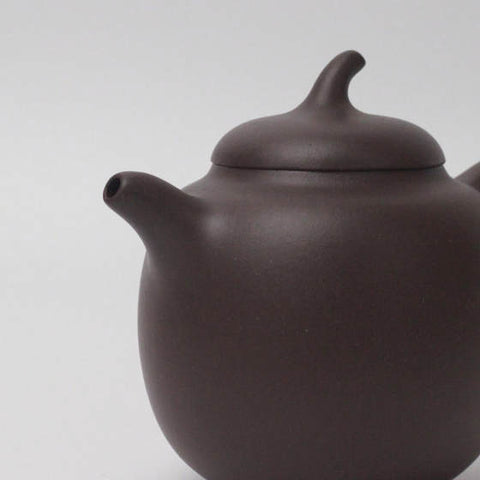Yixing: Dicaoqing
(Originally published September 19, 2018)
We continue our series on Yixing clay, also known as zisha, by looking at Dicaoqing 底槽青, a kind of zini 紫泥 or purple clay.

Yixing Teapot made of Dicaoqing Clay
Chicken Eyes
Dicaoqing is one of the most well-known kinds of zini. It was originally mined from the now-closed no. 4 and no. 5 mines in Huang Long Shan 黄龙山 and is found when mining other zini. The ore of dicaoqing is easily identified by greenish grey spots, referred to as “chicken eyes” 鸡眼 jiyan. The low amount of oxidized iron in these areas causes the greenish discoloration in the ore.

Dicaoqing ore on the left, dicaoqing teapot on the right

"Chicken eyes" in dicaoqing ore, photo taken from the book 阳羡茗砂土.
What’s in a name?
The name for dicaoqing comes from where the miners would find dicaoqing while mining zisha ore. After deciding where to dig, zisha miners would dig out a trench or “trough” (槽 cao) to mine the ore. The common name for zini at that time was “qingni” 青泥. Dicaoqing was found at the bottom (di 底) of the trench (cao 槽) of qingni (青泥). The name dicaoqing 底槽青 roughly translates to “at the bottom of the qingni trench”.
Red or Purple
One of the interesting things about dicaoqing (although not unique to this clay), is how firing temperature affects the final color of the clay. The firing temperature for the clay is between 1150-1250°C. Between that range the color of dicaoqing changes drastically. Firing at a lower temperature, such as around 1150-1170°C results in a dark red that can be described as sienna or “pig liver red." Firing at a higher temperature results in a much darker color, closer to dark brown/purple.

Dicaoqing clay fired at different temperatures

(Above) Dicaoqing fired at medium temperature is redder than (below) the clay fired at high temperature. Photo and captions from the book 阳羡茗砂土.
A Clay for a Versatile Teapot
Dicaoqing can be used like a zini clay teapot. Zini or purple Yixing clay is favored by Chinese tea drinkers because of its versatility. Not as porous as duanni, but more porous than zhuni, dicaoqing, like all zini clay teapots, is seen as a good clay for most kinds of tea. We find that sheng and shu puer, green oolong, yancha, black tea, all do well in this kind of clay.

Dicaoqing Teapot fired at a temperature of over 1200C.
